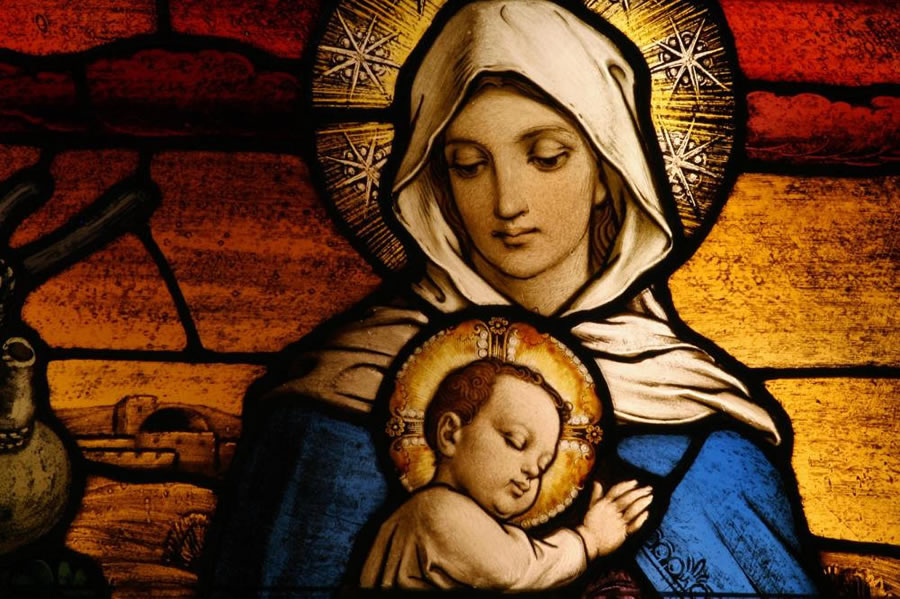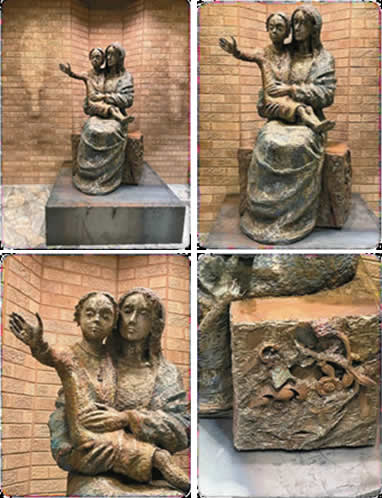
Our new statue of Mary and the Jesus
by Rev. Gabriel Baltes, O.S.B. | 06/25/2023 | A Message from Our PastorDear Parishioners,
Our new statue of Mary and the child Jesus has been in the church for two weeks now and the reception of this original piece of art, by our parishioners, has been overwhelmingly favorable. Like all fine art, this image of the Mother of God keeps revealing its beauty and spiritual significance the more one ponders it. I believe this is how one comes to appreciate art of any genre or medium, by standing back from it and viewing it with a contemplative eye over a period of time.
I have spent several hours at various times of the day in prayerful contemplation before this statue. I continually discover new features of its craftsmanship as well as new dimensions of its meaning. I share some of these below.

First, I believe the statue is faithful to our parish and school motto of Tradition with Vision. Traditionally, it portrays the Virgin Mary as she has been depicted for centuries, i.e., seated and holding her Son Jesus. The visionary aspect of this piece is evident in the material used by the artist, i.e., corten steel that has been shaped by welding as opposed to other materials such as bronze that is melted and poured into a mold, or wood or stone that are carved.
Corten Steel (sometimes known as weathered steel) is a group of steel alloys that are often used in outdoor construction. It was originally designed to help build railroad coal wagons in the 1960s. The success of the coal wagons inspired artists to use it for their work, especially for outdoor objects because it eliminated the need for painting. If left outside, exposed to the elements, corten steel develops a rusted appearance in just a few months which is part of its unique charm. The fact that this material is composed of various and different alloys is a symbolic expression of the Catholic church in this country, which from its inception, was made up of people from a great variety of ethnic backgrounds, walks of life, and economic ranks. In many ways, corten steel evokes the universal nature of our Catholic faith both in the US and abroad. That corten steel has been used to construct everything as mundane as coal wagons to lofty skyscrapers testifies to its sturdy adaptability which might also be said of the people of this land. In addition to all this, it reminds us of the sacramental nature of matter that is honest and authentic. It is permeated by God’s grace. Thus, steel is no less sacred or noble than marble, wood or gold. All substances have a capacity to reveal the Divine Presence which takes the stuff of the earth, the work of human hands, and transforms it into a sacramental reality to be a vehicle of grace.
Another striking feature of our statue is the posture which Mary is given. She is seated in the same manner as the renowned teachers and philosophers of the ancient world. These would take their places on a bench or special chair in the midst of their students who gathered around them, even at their feet, to drink in the knowledge and wisdom they had to offer. This seated posture was also assumed by priests and bishops as they peached their sermons and homilies.
One of Mary’s ancient titles is Sedes Sapientiae – “Seat of Wisdom.” This nomenclature recognizes Mary as a great wisdom figure who imparts the knowledge of her Son to those who willingly recognize their hunger for the knowledge that only God can give. As the arms of Mary offer her Son to the gathered assembly in the church, we are invited to draw from this font of wisdom that leads us closer to God.
Regarding the bench upon which the figure of Mary is seated, it is significant that it is adorned with flowers, vines and other paradisal imagery. Mary, as the New Eve, takes us back to the Garden of Paradise – to reclaim the beauty and innocence that the world possessed before the sin entered the world. Through Mary, we come to understand that God’s plan for creation was original blessing and not original sin, and that even though humanity is wounded by the Fall, it has always retained the capacity to receive God’s grace because we were fashioned in his image and likeness.
To be continued…
BACK TO LIST BACK